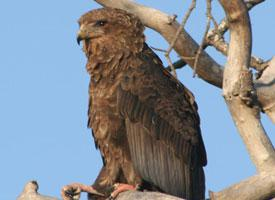
Poids et mesures
| Longueur | de 95 à 125 cm |
|---|
Description de l'animal
The Bearded Vulture, scientifically known as Gypaetus barbatus, stands out as one of the most fascinating and distinctive birds of prey in the avian kingdom. This remarkable species is part of the Accipitridae family, which includes eagles, hawks, and kites. However, the Bearded Vulture has unique characteristics that set it apart from its relatives.First and foremost, the Bearded Vulture is notable for its striking appearance. Adults exhibit a predominantly dark grey to black plumage, with a rust or orange tint that is the result of dust-bathing in soils rich in iron oxide. This behavior is unique among birds and adds to the mystique of the species. The bird's name derives from a tuft of feathers beneath its beak, resembling a beard, which adds to its distinguished appearance. Their wings are broad and long, providing them with remarkable soaring capabilities that are essential for their scavenging lifestyle.
With a wingspan that can reach up to 2.8 meters (9 feet), the Bearded Vulture is one of the largest raptors in its range. Despite its formidable size, it exhibits an elegant flight pattern, utilizing updrafts to glide over mountainous terrains with minimal effort. The Bearded Vulture inhabits a vast range that spans from the mountains of southern Europe, across the Middle East, and into parts of Asia and Africa. It prefers rocky, high-altitude environments, where it can be found soaring above the rugged landscape in search of food.
Unlike most birds of prey, the Bearded Vulture has a highly specialized diet that is primarily composed of bones. It is known colloquially as the "bone-eater" for this reason. The bird's strong stomach acid allows it to digest bone material efficiently, extracting nutrients that are inaccessible to most other animals. This unique feeding habit plays a crucial role in the ecosystem by helping to clean up carcasses. The Bearded Vulture is also known to carry bones high into the air and drop them onto rocks to break them into smaller, more manageable pieces, a remarkable example of tool use among birds.
The breeding habits of the Bearded Vulture are as distinctive as its diet. Pairs are monogamous and often mate for life, nesting on inaccessible ledges in high cliffs. They lay one to two eggs, which are incubated for about 53 to 58 days. The parents are highly attentive, with both participating in the rearing of the chicks. The young vultures are dependent on their parents for a considerable period, not fledging until they are around 110 to 130 days old.
Conservation efforts for the Bearded Vulture have become increasingly important as its population faces threats from human activities. Habitat degradation, poisoning, and collisions with power lines are among the primary threats to this species. Conservation programs, including breeding in captivity and reintroduction into the wild, have been initiated to help stabilize and increase the population of this magnificent bird.
In conclusion, the Bearded Vulture, Gypaetus barbatus, is a truly unique bird of prey, with its distinct diet, remarkable appearance, and specialized behaviors. It plays a vital role in its ecosystem as a scavenger and is a symbol of the wild, untamed beauty of the mountainous regions it inhabits. Conservation efforts are crucial to ensuring that future generations can continue to marvel at this magnificent bird soaring through the skies.
Animaux similaires
Nouvelles photos d'animaux
Top 10 des animaux
- Dolphin gull (Leucophaeus scoresbii)
- Diana monkey (Cercopithecus diana)
- Moustached guenon (Cercopithecus cephus)
- Galápagos tortoise (Geochelone nigra complex)
- Russian tortoise (Testudo horsfieldii)
- Japanese macaque (Macaca fuscata)
- Stone loach (Barbatula barbatula)
- Greek tortoise (Testudo graeca)
- Common flying dragon (Draco volans)
- Colossal squid (Mesonychoteuthis hamiltoni)


